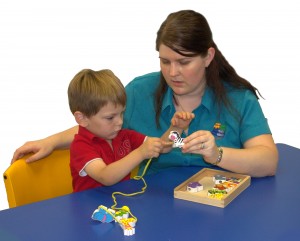
What questions should a preschool child be able to answer? Recently we have looked at simple questions for two and three year olds. Level three is a more complex level of questions and typically develops in preschoolers. At this level children talk about things which are more removed from what is directly in front of them. They need to reorganise information and draw on their experiences, to generalise, predict and to talk about the actions of others.
Level three questions include:
- Predicting “What will happen next?”
- Taking on the role of another “How would he fix it?”
- Following a set of directions “Get the cup and bring it to mummy”
- Retell a routine sequence “Tell me how to make a sandwich”
- Identifying similarities “How are these the same?”
- Understanding negatives “Find one that is not red”
- Defining words “What is a….”
To help a child learn to answer questions:
- give lots of practice with one question type before moving on
- keep your questions short, clear and specific
- give only a few choices, two or three pictures or objects to start with, and add more as your child learns
If your child does not know the answer you can:
- Rephrase your question as a question from a simpler level then try the question again
- Give them a choice “Is it is this one or this one?”
- Model the answer then try another similar question.
Try these activities to practice level three questions:
Story book predicting. Choose a book with a series of actions. Start with a book your child is familiar with and one where they know the story quite well. Read a page or two then stop and ask your child “What will happen next?” Continue to read asking this question now and then. When your child can do this with familiar stories try a new story and help them use cues from the story, the pictures and their own experiences to make predictions.
Story book role taking. Choose a story book with a problem to solve. Pamela Allen’s picture books are particularly good for this and commonly available, but many picture books have a problem based story line. Read the story and talk about the pictures together. As problems occur ask your child “What can he/she do?” Talk about the different options and why they may or may not work then turn the page and see what happens.
Real life role taking. As you do daily activities talk to your child about your actions and ask them to predict what you may do next. “Look my hair is a mess, what can I do?” “I can’t find my car keys, what can I do?” “Your sister spilt her drink, what will she do next?”
Sequences. As you do daily activities talk about the steps involved. “Let’s put the toothpaste on the brush, brush your teeth and then you can rinse”. Ask your child to tell you what steps they need to do in what order. Use a digital camera to take a series of photos, print and cut these out for your child to practice putting in order and retelling. These could include cooking and craft activities, daily activities and outings.
Obstacle course directions. Use a playground or set up some items in your backyard such as chairs, washing baskets, ropes laid out on the ground that your child can move around, on and over. You could also use items inside to allow your child to practice following instructions. Give your child a series of two or three instructions to follow e.g. “go around the chair, then under the table”. Gradually make your instructions more complex.
Shopping unpack directions. As you unpack the shopping give your child some instructions to follow “put the milk in the fridge and the apples in the bowl”. Once they are listening and following directions well give them some silly instructions “put the milk in the sink and the apples under the table”. This will check that they are really listening.
Negatives sorting. Get a box of Lego, blocks or beads and tip them on the floor or table. Ask your child “find me all the ones that are not red”. Repeat for some other colours then try sorting by shape or size, find all the ones that are not big, find all the ones that are not round. You could also try this when sorting washing “find all the things that don’t go on your legs” or putting away shopping “find all the things that are not for eating”.
Similarities match. Use a collection of picture cards of various different objects from a card game or make your own from clip art. Place all the pictures face up on the table and take turns to find two things that are similar and explain why they are the same. They might be in the same category “they are both fruit”, have the same function “both are for eating” or the same location “both are in the bathroom”. Keep matching until no more matches can be made. For added challenge place the pictures face down and turn them over two at a time and see if you can match the two that you choose. For extra fast thinking use the cards to play snap and make a match when you can tell something the same about two items.
Have fun practicing answering questions. If your child has difficulty with these tasks, see the Talking Matters website for how a speech pathology assessment may help.
Related Blog Posts
If you liked this post you may also like:
Using POP THE PIG To Grow
Multi-sensory words
Give books for Xmas
Grocery Shopping - Supporting Your Child's Development



